I am trying to calculate the value of x where y = 0. I could able to do it for single x using the following code
lm.model <- lm(y ~ x)
cc <- coef(lm.model)
f <- function(x) cc[2]*x + cc[1]
plot(x, y)
abline(coef(lm.model))
abline(h=0, col="blue")
(threshold <- uniroot(f, interval = c(0, 100))$root)
abline(v=threshold, col="blue")
x = c(33.05, 14.22, 15.35, 13.52, 8.7, 13.73, 8.28, 21.02, 9.97,
11.98, 12.87, 5.05, 11.23, 11.65, 10.05, 12.58, 13.88, 9.66,
4.62, 4.56, 5.35, 3.7, 3.29, 4.87, 3.75, 6.55, 4.51, 7.77, 4.7,
4.18, 25.14, 18.08, 10.41)
y = c(16.22699279, 15.78620732, 9.656361014, -17.32805679, -20.85685895,
7.601993251, -4.776053714, 10.50972236, 3.853479771, 7.713563136,
8.579366561, 14.16989395, 7.484692081, -1.2807472, -12.13759458,
-0.29138513, -5.238157067, -2.033194068, -38.12157566, -33.61912493,
-9.763657548, -0.240863712, 9.090638907, 7.345492608, 6.949676888,
-19.94866471, 0.995659732, -1.162616185, 5.497998429, 1.656653092,
2.116687436, 22.23175649, 10.33039543)
But I have multiple x variables. Now how can I apply it for multiple x variables at a time? Here is an example data
df = structure(list(y = c(16.2269927925813, 15.7862073196372, 9.65636101412767,
-17.3280567922775, -20.8568589521297, 7.6019932507973, -4.77605371404423,
10.5097223644541, 3.85347977129367, 7.71356313645697, 8.57936656085966,
14.1698939499927, 7.4846920807874, -1.28074719969249, -12.1375945758837,
-0.291385130176774, -5.23815706681139, -2.03319406769161, -38.1215756639013,
-33.6191249261727, -9.76365754821171, -0.240863712421707, 9.09063890677045,
7.34549260800693, 6.94967688778232, -19.9486647079697, 0.995659731521127,
-1.16261618452931, 5.49799842947493, 1.65665309209479, 2.11668743610013,
22.2317564898722, 10.3303954315884), x1 = c(8.56, 8.66, 9.09,
8.36, 8.3, 8.63, 8.78, 8.44, 8.34, 8.46, 8.33, 8.19, 8.58, 8.65,
8.75, 8.34, 8.77, 9.06, 9.31, 9.11, 9.26, 9.81, 9.68, 9.79, 9.26,
9.53, 8.89, 8.89, 10.37, 9.58, 10.27, 10.16, 10.27), x2 = c(164,
328.3, 0, 590.2, 406.6, 188.4, 423.8, 355.3, 337.6, 0, 0, 200.1,
0, 315.8, 547.5, 225.6, 655.7, 387.2, 0, 487.4, 400.4, 0, 234.9,
275.5, 0, 0, 613.2, 207.4, 184.4, 162.8, 220, 174.8, 0), x3 = c(4517.7,
2953.4, 2899.3, 2573.8, 3310.7, 3880.3, 3016.8, 3552.3, 2960.1,
323, 2638.5, 3343.1, 3274.7, 3218, 3268.3, 3507.9, 3709.2, 3537.5,
2634.4, 1964.6, 3333.7, 2809.7, 3326.8, 3524.5, 3893.9, 3166.7,
3992.1, 4324.7, 3077.9, 3069.9, 4218.9, 3897.4, 2693.9), x4 = c(14.7,
14.5, 15.5, 17, 16.2, 15.9, 15.7, 15.3, 13.5, 14, 15.4, 16.2,
15.6, 15.7, 15.1, 15.8, 15.3, 14.9, 15.7, 16.3, 15.21000004,
16.7, 15.6, 16.2, 15.7, 16.3, 17.3, 16.9, 15.7, 14.9, 13.81999969,
14.90754509, 12.42847157), x5 = c(28.3, 29.1, 28.3, 29.1, 28.7,
29.3, 28.9, 28.4, 29.3, 29.3, 29.1, 29, 29.9, 29.5, 28.4, 30.3,
29.1, 29.1, 29, 29.5, 29.3, 28.5, 29, 28.7, 29.4, 28.8, 29.2,
30.1, 28.3, 28.7, 24.96999931, 25.79496384, 25.3072052), x6 = c(33.05,
14.22, 15.35, 13.52, 8.7, 13.73, 8.28, 21.02, 9.97, 11.98, 12.87,
5.05, 11.23, 11.65, 10.05, 12.58, 13.88, 9.66, 4.62, 4.56, 5.35,
3.7, 3.29, 4.87, 3.75, 6.55, 4.51, 7.77, 4.7, 4.18, 25.14, 18.08,
10.41), x7 = c(13.8425, 11.1175, 8.95, 13.5375, 5.4025, 13.5625,
13.735, 14.14, 8.0875, 5.565, 12.255, 3.3075, 6.345, 4.8125,
4.0325, 11.475, 10.32, 17.71, 2.3375, 3.92, 5.7, 2.42, 8.3075,
7.4725, 7.7925, 10.8725, 8.005, 11.7475, 13.405, 8.425, 47.155,
26.1, 6.6675), x8 = c(0.95, 3.01, 1.92, 1.51, 2.61, 1.32, 3.55,
1.21, 2.14, 1.1, 1.32, 0.76, 1.34, 5.41, 9.38, 6.55, 4.44, 7.37,
9.84, 12.68, 15.52, 23.01, 18.59, 21.64, 19.69, 25.22, 22.38,
25.03, 37.42, 22.26, 2.1, 3.01, 0.82), x9 = c(26.2, 25.8, 25.8,
25.5, 26, 24.7, 22.9, 25.3, 26.3, 26.1, 22.5, 25.9, 26.4, 25.2,
25.8, 25.4, 25, 23.2, 26.4, 25.8, 26.6, 26.2, 25.8, 26.8, 25,
25.4, 25.6, 26.1, 25.7, 25.8, 24.78000069, 24.98148918, 26.39899826
), x10 = c(35.4, 39, 37.5, 36.4, 37.1, 36.2, 37.3, 36.4, 37.5,
36, 36.6, 35.6, 37.3, 38.3, 37, 37.5, 37.5, 39.6, 37.8, 36.8,
36.6, 38.4, 38.9, 38.4, 38.4, 37.7, 39.1, 37.7, 37.8, 39.4, 36.25,
35.57029343, 35.57416534), x11 = c(653.86191565, 383.1, 457.1,
591.4, 549.2, 475.2, 626.4, 308.8, 652.4, 77, 380.9, 530.5, 393,
712.1, 623.4, 515.7, 706.4, 713.4, 343.7, 559.5, 630.1, 292.3,
578.6, 628.88904574, 480.96959685, 591.35600287, 804.8, 419.6,
403.7, 361.2, 515.07101438, 434.66682808, 299.9531298), x12 = c(163.9793854,
167.9, 135, 215.8, 213, 188.4, 260.6, 191.8, 337.6, 55, 147.6,
200.1, 140.7, 315.8, 189.6, 225.6, 469.3, 201.8, 140, 297.2,
204.6, 142.5, 234.9, 275.494751, 153.7796173, 147.6174622, 433.6,
207.4, 184.4, 162.8, 219.9721832, 174.8355713, 106.8163605),
x13 = c(92, 67, 67, 50, 70, 87, 68, 86, 70, 11, 66, 79, 70,
61, 75, 78, 78, 77, 69, 35, 72, 76, 69, 84, 93, 73, 81, 99,
80, 76, 101, 86, 80), x14 = c(70, 42, 46, 34, 55, 60, 51,
65, 49, 1, 40, 56, 54, 41, 48, 57, 46, 50, 41, 22, 47, 47,
49, 57, 70, 52, 56, 70, 48, 50, 74, 66, 47), x15 = c(21,
12, 13, 10, 14, 16, 10, 13, 10, 0, 9, 14, 16, 20, 14, 14,
13, 15, 10, 7, 17, 8, 14, 14, 14, 11, 17, 19, 12, 11, 17,
17, 9), x16 = c(1076.8, 783.7, 711.8, 1041.9, 957.4, 939.3,
662.9, 768.1, 770.3, 0, 399.2, 606.2, 724.1, 960.8, 943.8,
737.8, 1477.4, 1191.7, 371.3, 956.4, 1251.7, 345.7, 1210.7,
845, 598.1, 821.7, 1310.6, 940.1, 581, 520, 313.5, 606.8,
201.2), x17 = c(163.9793854, 167.9, 128.4, 215.8, 213, 188.4,
260.6, 191.8, 337.6, 55, 147.6, 200.1, 140.7, 315.8, 189.6,
225.6, 469.3, 201.8, 140, 297.2, 204.6, 142.5, 234.9, 157.7472534,
153.7796173, 147.6174622, 133.1873627, 150.2, 184.4, 162.8,
219.9721832, 174.8355713, 106.8163605)), row.names = c(NA,
33L), class = "data.frame")


